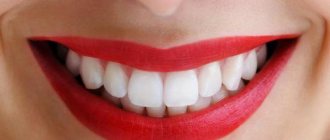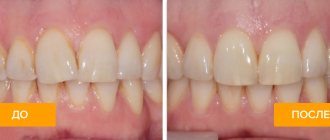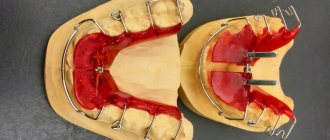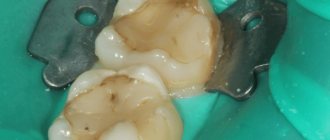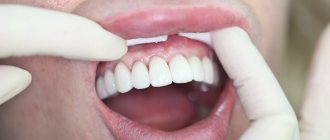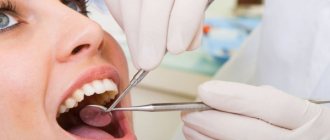Braces are metal clasps that are attached to the teeth. But they themselves do not correct the position of the teeth - the braces system does this. The main element of the system is the arc. It is this that affects the teeth, causing them to move. To do this, the arch is changed several times during the treatment process.
Arches for braces are made of a metal alloy. Most often it is nickel and titanium or titanium and molybdenum. At the request of the patient, you can choose an arch with a white coating - it visually goes well with ceramic or sapphire braces and is almost invisible. True, the white coating wears off quickly, so such an arch can be considered more as an option for a special occasion, for example, a wedding or graduation.
With a white arch, transparent braces are almost invisible
Basic properties of the arc:
- Strength. Braces can come off from the teeth, especially if you do not follow the rules of nutrition (gnaw nuts, crackers). But it is almost impossible to break or bend the arc.
- Flexibility and resilience. Regardless of what position the arch takes, it will tend to its original shape, similar to half an oval (except for the arch of lingual braces - it repeats the shape of the regular dentition not from the outside, but from the inside, so it looks different).
No matter how bent the arch is at the beginning of treatment, it tends to return to its shape
- Hypoallergenic. The arc is made of a material that does not cause allergies and a metallic taste in the mouth. It is not magnetic and does not “ring” at the airport when going through security.
How is crooked teeth corrected?
Each bracket is attached with a special composite adhesive to the surface of the tooth. This is a very crucial moment responsible for achieving a positive result. The way your doctor attaches the brackets affects the tooth's ability to move in a given direction. The pressure of the arch product is transferred to the brackets, allowing you to “control” the teeth.
It may seem that an orthodontic archwire is a simple wire. But this is absolutely false. The design, depending on the profile, tension force and cross-section, is designed to solve certain problems.
The structures are attached to the root teeth, and the brackets are attached to them using ligatures.
How strongly the wire will press on the teeth is determined by its fastener diameter and cross-section. The purpose of each set of arc products is different. Therefore, the groove into which the fastening element is threaded must have a specific slot direction for each element.
Rules for caring for teeth with installed braces
Braces are protruding elements, so when eating food, food residues can easily be fixed on them. It is because of this that you need to brush your teeth after every meal, this way you can effectively eliminate any leftovers.
You need to brush your teeth with braces using an Ortho brush with bristles of different lengths that allow contact with both the braces and the tooth surface. It is necessary to carry out sweeping movements along a row of teeth, starting from the farthest part of them to the center. In this case, it is necessary to apply the same amount of force to the brush as, for example, when using an eraser in order to remove a pencil inscription.
Also, in addition to the brush, you need to use a brush that penetrates well into the space between the surface of the tooth and the arch. In this case, movements must be made along the tooth surface, they cannot be carried out outward, in the direction from the tooth, if the brush is under the arch, otherwise, by pulling the arch, the bracket can be torn off from the tooth. You also need to use floss - dental floss, which will clean the interdental spaces, since food debris fibers can easily penetrate into the interdental spaces and cause caries.
You need to use dental floss at least once a day. If during the day it is not possible to brush your teeth after eating, you need to rinse your mouth well and remove any remaining food. If you use an electric toothbrush, don't change your habit. In this case, the working part of the brush should be located on 1 tooth, maximum attention should be paid to the cervical area (gum-tooth border).
Orthodontic arch
The most important part of the bracket system is the orthodontic arch. It creates pressure on the teeth, pulling them in the desired direction.
Note: This design is made at the first stage of treatment for each client individually. In this case, the predicted result of the location of the teeth is taken into account.
The metal from which the leveling product is made is able to remember its original position. The structure is stretched on the teeth, and it tends to its original shape, so the dentition gradually straightens.
Leveling structures can be different, depending on their purpose, cross-sectional shape, material and the use of additional capabilities.
According to the cross-sectional shape, the structures are round, square and rectangular. Designs of rectangular and square cross-section are better secured in the groove of the plate, moving not only the tooth, but also its root.
Based on the place of attachment, there are designs for the upper and lower jaws.
Additional options for orthodontic arches are as follows:
- reversible elements;
- hinged elements.
The duration of treatment with braces is one and a half to two years. In order to gradually increase the load on the dentition, arch products are changed three times during this time. More frequent replacement is also possible, especially if the product breaks down.
Application in orthodontics
Orthodontic facebows are designed to treat patients who have an improperly developed jaw or lack of space in the dentition—crowding or misaligned teeth.
A facebow in orthodontics looks like an elastic concave arch made of metal with special loops along the edges and in the middle for fixation. The central loop is secured to support rings that are placed on the teeth. And the side loops are attached to a bandage that is attached to the neck or head.
Types of material
Arches for braces have different diameters and cross-sections. Let's consider their classification according to different criteria.
Types of arches, relative to the material used for their manufacture:
- high quality steel;
- titanium alloy with molybdenum;
- titanium alloy with nickel;
- an alloy of copper, nickel and titanium.
According to the cross-sectional shape, arcs with a round, square and rectangular cross-section are distinguished.
Types of structures relative to the mounting location:
- on the upper jaw;
- on the lower jaw.
Types of designs regarding additional capabilities:
- element with closing loops;
- reversible elements.
Types of braces according to installation site
Since you will have to wear braces for a long time, when choosing devices to straighten your bite and teeth, patients first of all pay attention to aesthetics. Quite often, the invisibility of the design when smiling is a compelling argument in favor of choosing a specific modification. That is why it will be useful for you to know that bracket systems are divided into two types according to the type of fixation:
- Vestibular
. Attached to the outside of the teeth. The most common brace systems that can correct even the most complex orthodontic defects. Since the plates are attached on the outer side, they will be visible when you smile. The materials used are metals, gold-containing alloys, ceramics and sapphire crystals. Locks or ligatures are used to secure the arch. If the result is in the first place for you, and not the invisibility of the braces, then choose vestibular models. - Lingual
. Attached to the inside of the teeth. They are used less frequently than vestibular ones, since they are more expensive and require highly qualified doctors who will install this brace system. Most often, before starting orthodontic treatment, additional diagnostics are required, including three-dimensional modeling of the predicted process of bite/teeth alignment.
The effectiveness of both types is approximately equal. The difference is that ligatures require greater precision in treatment planning and installation.
| Advantages | Flaws |
| Vestibular | |
|
|
| Lingual | |
|
|
How the arc works
The metal alloy from which leveling structures are made remembers its shape.
So, they constantly strive for their original position, and being on the teeth, they move them along with them.
Therefore, the pressure on each tooth is transferred from the wire to the bracket, and from it to the tooth. And the more the tooth does not correspond to the shape that the arch is striving for, the more it puts pressure on it.
With gradual movement, the pressure on the tooth decreases. During treatment, some leveling devices are replaced by others, relying on the achieved result.
Application in orthopedics
A facial bow in orthopedics eliminates inaccuracies in the manufacture of various structures and helps to correctly transfer the anthropometric data of each patient. It is used in various types of prosthetics, from single crowns to total work with complete or partial loss of teeth, for the manufacture of veneers and crowns.
There are two types of orthopedic face bows:
- Standard or average anatomical - most often used for the manufacture of removable dentures. This facebow consists of a hinge, a frame, a nose piece and a bite fork. All these parts are connected together and fixed to each other, and then attached to the anatomical structures of the head: the frame to the ears, the nose pad to the bridge of the nose, and the bite fork to the teeth of the upper jaw. If the patient has no teeth, a special template is used.
- Kinematic - selected when it is necessary to manufacture partial dentures. Unlike the standard one, the kinematic facebow does not have a frame and is not fixed in the ears; it is attached to the chin and bridge of the nose.
After the silicone has hardened, the bite fork is removed from the oral cavity, then the model of the upper jaw is plastered in the articulator on the transfer table, and the model of the lower jaw is plastered to the upper jaw. This is how the articulator forms the correct position of the jaws relative to each other, which orthopedists use to model teeth, make veneers and crowns, dentures and other structures supported by teeth and implants. Thanks to this approach, we achieve the best aesthetic parameters of a smile.
Arc section shape
Types of arc products according to cross-sectional shape:
- Round (0.14, 0.16 or 0.18) - very elastic and not very hard, so they are used in the first stage of straightening.
- Rectangular (0.16 × 0.22 or 0.17 × 25) - they are used in the middle of treatment.
- Square (16x16 or 175x175) - used at the end of treatment.
Thus, during treatment, structures with a round cross-section are usually replaced first with rectangular ones and then with square ones. How and when to replace the arches depends on the specific case and is decided by the doctor.
Pros and cons of an orthodontic facebow
The effectiveness of the facebow in orthodontic treatment cannot be underestimated. The device has undeniable advantages:
- provides quick treatment results - correction requires no more than 6 months;
- highly effective - the face bow helps to correct even complex cases;
- comfortable - you can wear the arch at home; it must be installed for 10-12 hours. If you are embarrassed to wear the device on the street or at work, just put it on for a couple of hours in the evening and leave it on at night.
Despite the advantages, the orthodontic facebow has disadvantages. These include the rather large size of the entire structure and not the most reliable fixation. If used incorrectly, the fastener may move away from the fixing rings and injure the mucous membrane.
Arch replacement
Typically, during the entire process of correcting the bite, 3 pairs of arches for braces are replaced. For complex defects, when the duration of treatment increases, the number of replacements should also be increased. Each subsequent pair of arch products differs from the previous one in greater rigidity in order to gradually increase the load on the teeth.
How many times it is necessary to change, and what designs, the orthodontist decides, relying on the characteristics of a particular case. There are situations when a patient asks to replace the arch unscheduled. Indeed, if improperly maintained or as a result of injury, the structure may break. Then the unsuitable wire on the upper or lower jaw is replaced. During a planned replacement, both structures are replaced.
Replacing the arches is easy and fairly quick. By opening the clasps of the braces or removing the ligatures, the specialist removes the old wire from the grooves, then installs and fixes a new one. The patient does not feel any discomfort.
Stages of the procedure
The repositioning of the power element takes place during a scheduled visit to the orthodontist after assessing the result of the treatment. If there is a change in the position of the teeth (compared to the last visit), the doctor decides to place a new wire with stronger pressure.
Based on the type of design, for replacement, the locks are opened or the ligatures are removed . Then the arc is removed from the grooves, and a new one is installed in its place.
When working, the orthodontist uses special forceps to remove and subsequently install the element, distal pliers, which shorten the arch, and contour forceps.
The procedure is quick and painless for the patient. However, during the first few days you may experience some discomfort and slight pain due to increased pressure on the teeth.
Replacements differ in position. There is a vestibular (external) type of replacement, when the process is performed from the outside of the tooth surface. And there is also a lingual type, when all actions are carried out from the internal (lingual) side.
Important! Any attempt to independently extract or tension the arch may affect the progress of correcting the defect of the dentofacial apparatus. Therefore, any manipulations must be carried out by a specialist.
In most medical institutions, the replacement procedure is paid separately (the price usually includes the doctor’s work and the cost of the element itself).
In a situation where a person has to go to another clinic to replace the arch due to its breakdown, specialists there are not always ready to undertake such a “one-time” procedure.
If the change has not been refused, then a follow-up treatment agreement must be concluded with the patient. It provides for payment not only for the replacement process itself, but also for the development of a new defect correction plan and removal.
The video shows the operation of changing arches during orthodontic treatment with braces.
Most common problems
There are different cases when wearing braces. The arch may break off as a result of improper use of the structure or the use of the wrong material for its manufacture, fly out of the last bracket, and so on. What to do in this case? Let's look at each situation in more detail:
- The last lock of the bracket does not fix the arch very firmly, for this reason the structure may fall out of it. But this is no reason to worry. There is no need to change the design. And the patient can reattach it independently. Standing in front of the mirror and using tweezers, you can carefully insert the end of the wire into the hole in the lock. Try to be as precise as possible.
- It is also possible for the arch to bulge and cause injury to the soft tissues of the oral cavity. The case is unpleasant, and to solve it you need the help of an orthodontist. He will either replace the structure or simply trim the ends of the wire.
- If a wire falls out of a lock that is not the last one, you also need to contact a specialist. And as early as possible. After all, this is how the arc changes its position and can ruin the entire treatment process.
- If the arc breaks, it can only be replaced. Again, only an orthodontist can do this. Before visiting him, you can protect the soft tissues of the oral cavity by treating the protruding edge of the wire with wax.
Stages of treatment with orthodontic arches
There are 3 stages of treatment with arch structures for braces:
- Arcs of significant elasticity, in order to avoid deformation, guide the teeth in the desired direction.
- More rigid structures with a larger cross-section are used. Such structures are capable of expanding not only the tooth, but also its root. That is, instead of an inclined one, their movement is carried out by the body.
- A rigid, but sufficiently elastic arch is used, simplifying the fit of the bite.

